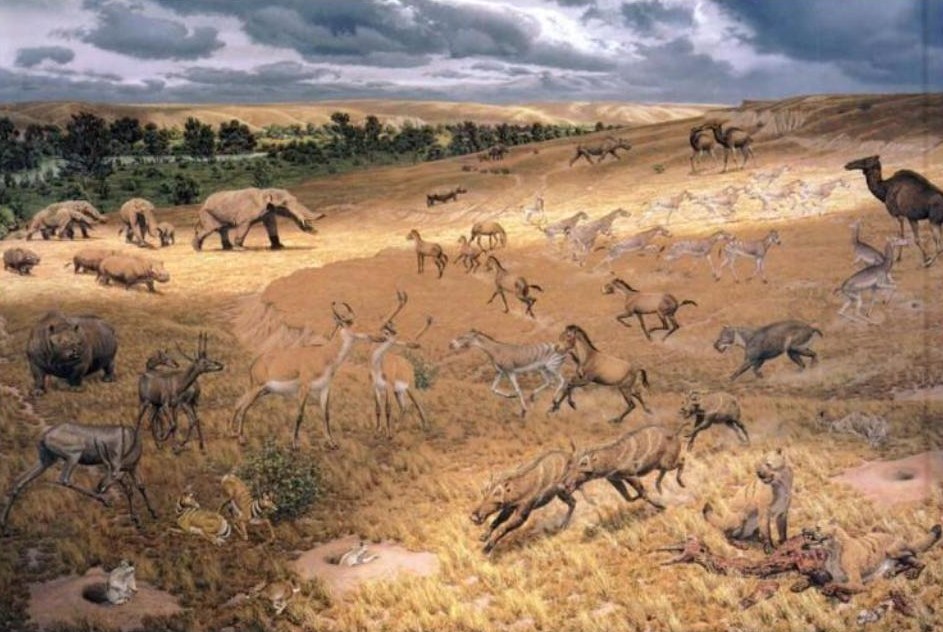Post by Infinity Blade on May 16, 2015 4:00:16 GMT 5
Synthetoceras spp.

Portrait of S. tricornatus in anterior view. © @ Lucas Lima.
Temporal range: Miocene (Tortonian-Messinian: ~10.3-5.33Ma[1])
Scientific classification:
Life
Domain: Eukaryota
(unranked): Unikonta
(unranked): Opisthokonta
(unranked): Holozoa
(unranked): Filozoa
Kingdom: Animalia
Subkingdom: Eumetazoa
(unranked): Bilateria
Superphylum: Deuterostomia
Phylum: Chordata
Infraphylum: Gnathostomata
Clade: Eugnathostomata
Clade: Teleostomi
Superclass: Tetrapoda
Clade: Reptiliomorpha
Clade: Amniota
Clade: Synapsida
Clade: Eupelycosauria
Clade: Sphenacodontia
Clade: Sphenacodontoidea
Order: Therapsida
Suborder: Cynodontia
Clade: Prozostrodontia
Clade: Mammaliaformes
Class: Mammalia
Legion: Cladotheria
Sublegion: Zatheria
Infralegion: Tribosphenida
Subclass: Theria
Clade: Eutheria
Infraclass: Placentalia
Subcohort: Exafroplacentalia
Magnorder: Boreoeutheria
Superorder: Laurasiatheria
Clade: Ungulata
(unranked): Cetartiodactyla
Clade: Artiofabula
Clade: Cetruminantia
(unranked): Ruminantiamorpha
(unranked): Ruminantia
Infraorder: Tragulina
Family: †Protoceratidae
Subfamily: †Synthetoceratinae
Tribe: †Synthetoceratini
Genus: †Synthetoceras
Species: †S. tricornatus
†S. davisorum
Synthetoceras spp. ("combined horn") was a genus of protoceratid ungulate that lived in North America during the Miocene epoch ~10.6-5.33 million years ago.[1]
Description:
Two specimens had their weight estimated by Mendoza et al. (2006). Between the two specimens, body mass ranged from 228.3-332.4 kilograms.[2] The animal possessed orbital horns but is most well-known for its long, forked nasal horn resembling a Y or a slingshot. Synthetoceras was apparently sexually dimorphic in that only males had the aforementioned unusual nasal horn, which was likely utilized for intraspecific conflict.[3] At least the rostral horns of protoceratids (and thus including Synthetoceras) were likely covered in skin.[4]

Skull of S. tricornatus.
References:
[1] fossilworks.org/bridge.pl?a=taxonInfo&taxon_no=42584&is_real_user=1
[2] "Estimating the body mass of extinct ungulates: a study on the use of multiple regression" (Mendoza et al., 2006).
[3] Douglas Palmer (1999). The Marshall Illustrated Encyclopedia of Dinosaurs and Prehistoric Animals. p. 273.
[4] Donald R. Prothero & Robert M. Schmoch (2002). Horns, Tusks, and Flippers: The Evolution of Hoofed Mammals. p. 63.

Portrait of S. tricornatus in anterior view. © @ Lucas Lima.
Temporal range: Miocene (Tortonian-Messinian: ~10.3-5.33Ma[1])
Scientific classification:
Life
Domain: Eukaryota
(unranked): Unikonta
(unranked): Opisthokonta
(unranked): Holozoa
(unranked): Filozoa
Kingdom: Animalia
Subkingdom: Eumetazoa
(unranked): Bilateria
Superphylum: Deuterostomia
Phylum: Chordata
Infraphylum: Gnathostomata
Clade: Eugnathostomata
Clade: Teleostomi
Superclass: Tetrapoda
Clade: Reptiliomorpha
Clade: Amniota
Clade: Synapsida
Clade: Eupelycosauria
Clade: Sphenacodontia
Clade: Sphenacodontoidea
Order: Therapsida
Suborder: Cynodontia
Clade: Prozostrodontia
Clade: Mammaliaformes
Class: Mammalia
Legion: Cladotheria
Sublegion: Zatheria
Infralegion: Tribosphenida
Subclass: Theria
Clade: Eutheria
Infraclass: Placentalia
Subcohort: Exafroplacentalia
Magnorder: Boreoeutheria
Superorder: Laurasiatheria
Clade: Ungulata
(unranked): Cetartiodactyla
Clade: Artiofabula
Clade: Cetruminantia
(unranked): Ruminantiamorpha
(unranked): Ruminantia
Infraorder: Tragulina
Family: †Protoceratidae
Subfamily: †Synthetoceratinae
Tribe: †Synthetoceratini
Genus: †Synthetoceras
Species: †S. tricornatus
†S. davisorum
Synthetoceras spp. ("combined horn") was a genus of protoceratid ungulate that lived in North America during the Miocene epoch ~10.6-5.33 million years ago.[1]
Description:
Two specimens had their weight estimated by Mendoza et al. (2006). Between the two specimens, body mass ranged from 228.3-332.4 kilograms.[2] The animal possessed orbital horns but is most well-known for its long, forked nasal horn resembling a Y or a slingshot. Synthetoceras was apparently sexually dimorphic in that only males had the aforementioned unusual nasal horn, which was likely utilized for intraspecific conflict.[3] At least the rostral horns of protoceratids (and thus including Synthetoceras) were likely covered in skin.[4]

Skull of S. tricornatus.
References:
[1] fossilworks.org/bridge.pl?a=taxonInfo&taxon_no=42584&is_real_user=1
[2] "Estimating the body mass of extinct ungulates: a study on the use of multiple regression" (Mendoza et al., 2006).
[3] Douglas Palmer (1999). The Marshall Illustrated Encyclopedia of Dinosaurs and Prehistoric Animals. p. 273.
[4] Donald R. Prothero & Robert M. Schmoch (2002). Horns, Tusks, and Flippers: The Evolution of Hoofed Mammals. p. 63.






 Ah! Nostalgia! Anyone know where to find it? That book's not at my local library(as far as I know...)
Ah! Nostalgia! Anyone know where to find it? That book's not at my local library(as far as I know...)